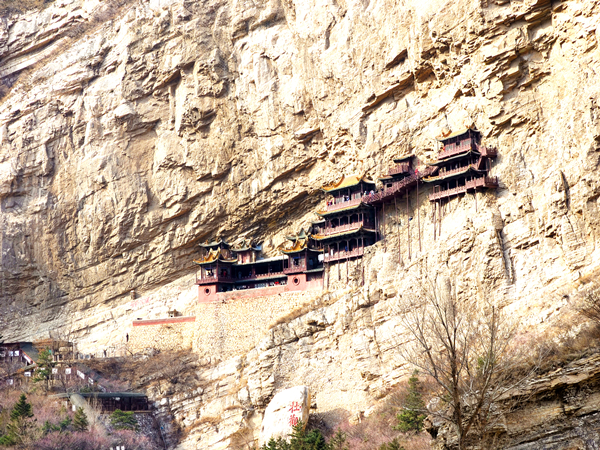


Mysterious history of the Hanging Temple

The Hanging Temple is a historical marvel of mechanical theory and human skills. Photo: TUCHONG
The Hanging Temple of Mount Heng, Shanxi Province, is well known across the country, but its history and origins are shrouded in mystery.
Mysterious origins
One view suggests that the temple was originally built during the late Northern Wei Dynasty, approximately 1,400 years ago. In 398, before his death, Taoist master Kou Qianzhi, a high priest of the Northern Wei Dynasty, expressed a wish to build a temple suspended in the air to “ascend to the sky and detach from the world’s noise.” He envisioned this temple as a place where visitors could feel a sense of communion with celestial beings and leave their worldly concerns behind. For 43 years following Kou’s death, his disciples raised funds, carefully selected an ideal location, and designed the temple. In the end, a remarkable architectural feat was accomplished. Proponents of this view believe that the Hanging Temple, perched more than 50 meters above the ground, was built with the original purpose of bringing people closer to Heaven.
Another view suggests that around 386, the Xianbei, an ancient nomadic population that once resided in the eastern Eurasian steppe, began an ambitious campaign towards the south under the leadership of Tuoba Gui. They set out from Gaxian Cave in the Great Xianbei Mountains (now part of the Da Hinggan Range), headed westward, defeated numerous non-Xianbei tribes, advanced into present-day Inner Mongolia, and established the Northern Wei Dynasty in what is now Hohhot. However, when preparing for the march towards south, the Xianbei encountered the obstruction of Mount Heng. After carefully examining the mountainous terrain, Tuoba Gui decided to build a military outpost along the Jinlong Gorge water system at the foot of Mount Heng. This outpost later became the precursor to the Hanging Temple, indicating that it was originally a military station built by the Xianbei people. It was later converted into a temple based on Kou Qianzhi’s suggestion, eventually becoming the Hanging Temple we see today.
Following this, Tuoba Gui continued his southern campaign into the Central Plains, eventually reaching Pingcheng (modern Datong in Shanxi Province), where he established a new capital. Evidence supporting the theory that the Hanging Temple was transformed from a military outpost includes numerous square holes along the mountain’s western slopes. These holes are believed to be remnants of square wedges hammered into the rock by the troops of Tuoba Gui when they tried to build a walkway on the cliff.
These views have not yet been definitively proven, but I find the second one quite plausible.
Architectural characteristics
The most distinctive feature of the Hanging Temple is its construction along the sheer cliff face at a mid-mountain elevation. The design of the temple creates an illusion that its top seems to disappear into the clouds when viewed from below, while the structure itself appears to float without any support from the ground. This gravity-defying architecture lends the temple a unique and mysterious aura.
In reality, the temple’s structural support does not rely at all on the tall, visible wooden stilts of Chinese fir. Upon closer inspection from above, the true support of the temple is hidden in the 27 large beams driven into the mountain beneath the temple. These beams are not fully embedded; rather, roughly four-fifths of each beam is inserted into the mountain, while the remaining one-fifth is exposed and interlocks with the visible Chinese fir stilts, creating a stable support system for the temple. The function of these stilts—whether they were used by the artisans or by the Xianbei people in their military fortifications—remains unknown.
In ancient times, craftsmen likely hung suspended in mid-air like “spidermen,” working along the pre-surveyed cliffside to set beams, erect houses, nail rafters, lay tiles, and connected pavilions with wooden walkways. The Hanging Temple, appearing as if it is precariously clinging to the mountainside with its Chinese fir stilts yet without visible supports, presents a formidable challenge for visitors to fully appreciate its perilous allure.
Today, the temple complex still houses the “Mahavira Hall” and 10 other stone grotto halls. It also features inscriptions from the Jin and Ming dynasties, including plaques, Buddha niches, and statues. Additionally, the temple is home to 78 precious Confucian, Taoist, and Buddhist figures made from bronze, iron, and clay, as well as various inscriptions—all considered national treasures.
Inside the temple, visitors navigate narrow corridors with peeling paint, instinctively pressing against the walls for support. Despite its age, the architecture remains remarkably sturdy. The path, which was once a narrow trail, quickly turns into a nearly vertical, iron-clad wooden staircase that requires both hands and feet to climb. Fortunately, as it is not peak tourist season, the line is not too long, allowing me to embark once again on a visit to the Hanging Temple.
Zhang Likang is from Chinese Academy of Social Sciences Library.
Copyright©2023 CSSN All Rights Reserved